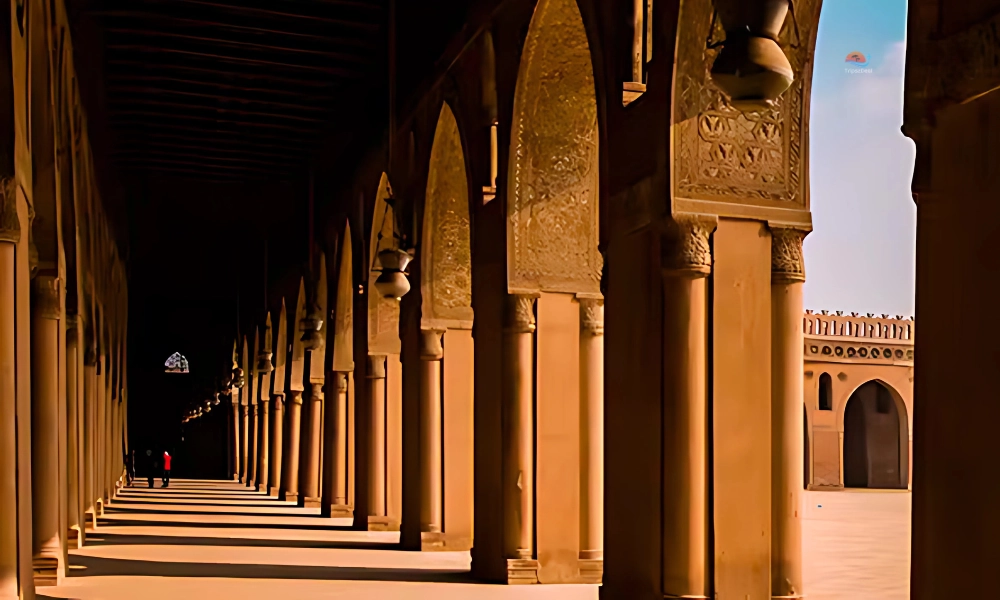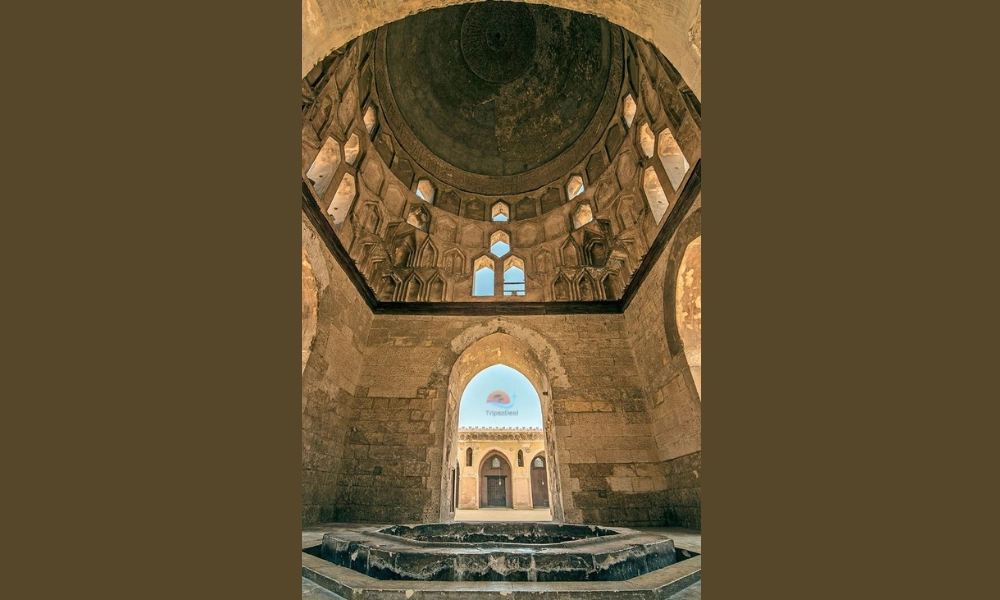Blogs

Ibn Tulun Mosque
Think about it, you’re cruising through the wide streets of Islamic Cairo, Egypt. It is the place where you find history permeating every nook and cranny. One the next moment, you’re standing in front of Ibn Tulun Mosque, one of the oldest and ancient mosques among the magnificent mosques. This mosque was constructed over 1,100 years ago, the most cultural and Islamic structure is not only a reason for visitors to grab attention, but it is also among the most preserved.
You’ll welcome silence as you enter the envelopes. You feel like, through a time machine, you’re back to the 9th century, when Cairo was an iconic symbol and central focus of Islamic art, tradition, and scholarship. This is all because of its open courtyard, spiral minarets, and endless, beautifully finished rows of arches. Beyond a place of worship, Ibn Tulun Mosque is a must-visit and a living example of ancient architecture and tradition.
This guide has been compiled to describe the significance, historical background, and ancient legacy of the Ibn Tulun Mosque. If you’re a traveler, a storyteller, and an explorer who loves history, prepare your visit list and set in Ibn Tulun Mosque as a priority.
Table of Contents
- 1. Historical Background of the Ibn Tulun Mosque
- 2. Architectural Brilliance of the Ibn Tulun Mosque
- 3. Symbolism and Religious Importance Through the Ages
- 4. Restorations and Preservation Efforts
- 5. The Mosque in the Modern Cairo Landscape
- 6. Ibn Tulun Mosque as a Cultural and Tourist Attraction
- 7. The Mosque in Pop Culture and Media
- 8. Educational and Spiritual Role in the 21st Century
- 9. Why Ibn Tulun Mosque Remains a Global Heritage Treasure
- 10. Conclusion:
1. Historical Background of the Ibn Tulun Mosque
Ahmad Ibn Tulun: Who Was He?
A Turkish Military leader who served the Abbasid Caliphate’s representatives in Egypt was the one who held the name of the Ibn Tulun Mosque. Moreover, very soon, he was given the role of governor. He also announced the Tulunid dynasty, which was one of the autonomous Islamic dynasties of that time. At that moment, he declared Egypt an Independent and free state in 868 CE.
- Strategic planner and Ambitious, Ibn Tulum wished to make Cairo very distinct and unique in comparison to other great capitals of the Islamic World. To empower his rule and devotion, he ordered the building of a monumental mosque, the one that is not only a spot of worship but a place where students seek Islamic knowledge, and also declares itself a political symbol of freedom.
Construction Timeline: 876–879 CE
This mosque is the oldest and ancient mosque in Cairo, but it still holds its significance due to preservation. It was constructed between 876 and 879 CE.
The Ibn Tulun delivers a very artistic style to a mosque of very early Islamic architecture because it has been preserved for a long time in comparison to other mosques that have been renovated and constructed.
Architectural Influences from Samarra, Iraq
The Samarra mosque in Iraq is one of the mosques that was very famous mosques during the Abbasid period because it served as a landmark symbol of Islamic culture and infrastructure.
Ibn Tulun once visited Samarra, after which he commissioned architects to transform Egypt as per the distinct design and art of the Islamic legacy. Such as a spiral minaret is one of the most recognized examples. The rank of mosque in Islamic history was determined as a blend of unique Egyptian and Iraqi artistic skills.

2. Architectural Brilliance of the Ibn Tulun Mosque
As you enter the monumental gateway, you instantly get mesmerized by the sheer size and sense of harmony of the mosque. This delivers an enhanced vibe of artistic culture.
Hypostyle Design and Unique Features
The mosque is a remarkable symbol of the hypostyle plan, offering rows of huge pillars coordinating the top flat roof. This artistic style aesthetic contains a wide and open prayer hall, enabling thousands of worshippers to offer prayer at once.
- Arched colonnades surround the central courtyard.
- The arches are decorated with stucco carvings, showcasing intricate geometric and floral patterns.
- The mosque’s simplicity and symmetry reflect early Islamic ideals of unity and devotion.
Use of Brick and Stucco Decoration
Ibn Tulun mosque’s structure does not follow the traditional design, like using marble or stone. That’s why the Ibn Tulun mosque was built with red bricks and plastered stucco at the very start. This chosen design reflects Samarra's inspired look, where the brick was the primary building material. Even though, after certain centuries, many stucco decorations are still preserved.
The Famous Spiral Minaret
Think about it, you’re walking inside the mosque, you look at a most remarkable and iconic symbol, the spiral minaret. This design is influenced by the Great mosque of Samarra.
Moreover, explorers can visit the external staircase to get the whole view of Cairo at a glance. Imagine the ascending winding path and the ancient mosque touching your soul from the core. This is an amazing journey that delivers an iconic experience integrating spirituality with adventures.
The Courtyard and Ablution Fountain
As you move forward, you’ll find a wide and spacious open courtyard in the middle of the mosque that allows the light and air to pass. Then, you’ll see an amazing fountain for ablution in the center, where worshippers can do ablution before offering a prayer.
The wideness of the courtyard delivers tranquility and humbleness among the visitors and worshippers there.

3. Symbolism and Religious Importance Through the Ages
Throughout the historical journey, this mosque has been a most significant piece of religious life in Cairo, Egypt.
- During the Tulunid dynasty, it was the central congregational mosque.
- In the Fatimid and Mamluk periods, the mosque continued to serve worshippers and scholars alike.
- Its design accommodated different schools of Islamic thought, making it a symbol of inclusivity.
The mosque’s importance has determined its spiritual and cultural influence in Cairo, Egypt.
4. Restorations and Preservation Efforts
Major Renovations in the 13th and 19th Centuries
Because of external and natural factors, the mosque faced a lot of challenges regarding damage and destruction. But, still it was renovated and maintained many times, like as:
- Sultan Lajin commanded modern renovation and development in the 13th century. It contained an addition of a current ablution fountain for worshippers.
- In the reign of Khedive Abbas I, in the 19th century, the mosque was repaired from the base, in order to keep it surviving for the upcoming times.
Comité de Conservation des Monuments de l'Art Arabe
In the late 19th and early 20th centuries, the Comité de Conservation des Monuments de l'Art Arabe, a pioneering preservation body, played a crucial role in restoring and maintaining the mosque.
Modern Conservation Efforts
UNESCO supports the Egyptian government, helping them to maintain and renovate the mosque, as it is internationally significant for its role as a living religious mark and a cultural heritage legacy.
5. The Mosque in the Modern Cairo Landscape
The Ibn Tulun Mosque may be ancient, but it remains woven into the fabric of modern Cairo.
- It sits in Sayeda Zeinab district, close to other historic landmarks.
- The mosque stands as a bridge between old Cairo’s Islamic quarter and the modern city.
- Despite Cairo’s urban sprawl, the mosque’s towering minaret and vast courtyard provide an oasis of calm.

Legacy and Global Influence of the Ibn Tulun Mosque
You can easily get the impression that you are a part of something much bigger than Cairo as you walk through the Ibn Tulun Mosque's arches. In addition to being a gem of Islamic Cairo, this mosque has influenced architecture and culture all over the world. Large courtyards, spiral minarets, and exquisite stucco work are some of its architectural features that have endured over centuries and continents.
Key Aspects of Its Legacy:
- Architectural Inspiration:
- Inspired later mosques in North Africa and the Middle East.
- Its spiral minaret, modeled after Samarra’s Great Mosque, became an iconic feature studied worldwide.
- Influence on Dynasties:
- Fatimid and Mamluk architects studied Ibn Tulun’s hypostyle design.
- The focus on harmony, space, and natural light shaped Cairo’s later architectural masterpieces.
- Global Academic Recognition:
- Frequently featured in Islamic architecture research and university studies.
- Exhibited in museums and exhibitions showcasing Islamic heritage.
- Modern Relevance:
- Still used as a case study in sustainable architecture.
- Inspires architects seeking durable yet beautiful design models.
In many ways, the Ibn Tulun Mosque is a living textbook of Islamic architecture. For Egyptians, it represents a proud cultural identity; for the world, it is a UNESCO-recognized heritage treasure, proof that architecture, when rooted in vision and spirituality, can transcend time.
6. Ibn Tulun Mosque as a Cultural and Tourist Attraction
Slowly moving in the mosque, many visitors’ silent footsteps deliver a reflection of soothing and peaceful essence.
Visitor Experiences
- Photography: The arches and shadows create stunning compositions.
- Tranquility: Unlike busier tourist sites, the mosque offers a quiet atmosphere.
- Panoramic Views: Climbing the spiral minaret rewards visitors with breathtaking views of Cairo.
Nearby Attractions
- Gayer-Anderson Museum: Located right next to the mosque, this 17th-century house showcases Islamic art, furniture, and antiques.
- Sayeda Zeinab Mosque: A nearby shrine that remains an active spiritual center for Cairo’s Muslim community.
Tips for Tourists
- Entry fee: The mosque is very affordable, sometimes free, depending on the season.
- Best time to visit: Morning or late afternoon, when light enhances the arches.
- Dress code: Modest clothing is required; women should bring a scarf to cover their hair.
7. The Mosque in Pop Culture and Media
The Ibn Tulun Mosque's architectural magnificence has been featured in a number of travel programs, documentaries, and motion pictures. Because of its distinctive design and meaning, academics, architects, and artists are still researching it.
The travel blogs, Instagram photos and reels, and traditional documentary legacy have increased their demand and attracted global attention towards the landmark masterpiece.

8. Educational and Spiritual Role in the 21st Century
Despite its age, the mosque continues to serve both educational and spiritual functions:
- Daily prayers are still held, connecting worshippers to centuries of tradition.
- Quranic education and lessons in Islamic heritage are occasionally organized.
- Universities and architectural institutes use the mosque as a case study in early Islamic architecture.
9. Why Ibn Tulun Mosque Remains a Global Heritage Treasure
In Islamic Cairo’s UNESCO World Heritage, the Ibn Tulun Mosque has stood out significantly internationally because of its design, which is a mix of present and past artistic vintage and aesthetic style. It is a treasure for the entire Islamic world, not just Egyptians, because of its architecture, size, and preservation.
It is recognized internationally as a masterpiece of early Islamic architecture, and it continues to attract visitors, scholars, and worshippers alike.
10. Conclusion:
You can practically hear the echoes of history as you stand in the expansive courtyard of the Ibn Tulun Mosque, from the voices of contemporary tourists who are in awe of its splendor to Ahmad Ibn Tulun's vision in the ninth century. Whether you are a worshipper drawn to its tranquility, a student studying Islamic history, or a tourist seeking beauty. This mosque is a living testament to Cairo's Islamic past, a historical treasure, and a spiritual landmark in addition to being a marvel of architecture. The Ibn Tulun Mosque serves as a timeless reminder of Egypt's enduring cultural and religious legacy.





